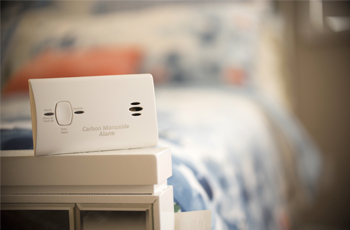
While the changing of seasons makes living in Pure Michigan idyllic, fall and winter can also bring a hidden danger with them. This time of year, we too often read or hear the sad news of someone suffering or dying from carbon monoxide poisoning.
What is carbon monoxide?
Carbon monoxide (or CO) is an odorless, invisible gas that can kill you or make you very sick. The longer your exposure to CO, the more concentrated and deadly it becomes.
Where is carbon monoxide found?
CO is found in fumes generated any time you burn fuel in cars or trucks, small engines, stoves, lanterns, grills, fireplaces, gas ranges, or furnaces. Because of improper combustion (burning), CO can build up indoors or in any closed environment, poisoning people and animals who breathe it.
Poisoning frequently happens by accident, but it can also be the result of intentional self-harm or suicide.
What are the symptoms of CO poisoning?
Contrary to urban legend, your skin will not turn cherry-red due to CO poisoning. Actual signs and symptoms of CO poisoning include;
Everyone is at risk of CO poisoning. That said, infants, older people, pets, individuals with certain chronic diseases (e.g., heart disease, anemia or breathing problems) are more likely to become ill from CO poisoning. Women who are pregnant are at greater risk because of fetal exposure to CO.
According to the Centers for Disease Control and Prevention (CDC), more than 400 Americans die annually from unintentional CO poisoning (not linked to fires), and over 20,000 visit the emergency room.
What should you do if you suspect CO poisoning?
Wishing you a warm, safe and healthy season,
Dr. Brian J Coté, FACEP
What is carbon monoxide?
Carbon monoxide (or CO) is an odorless, invisible gas that can kill you or make you very sick. The longer your exposure to CO, the more concentrated and deadly it becomes.
Where is carbon monoxide found?
CO is found in fumes generated any time you burn fuel in cars or trucks, small engines, stoves, lanterns, grills, fireplaces, gas ranges, or furnaces. Because of improper combustion (burning), CO can build up indoors or in any closed environment, poisoning people and animals who breathe it.
Poisoning frequently happens by accident, but it can also be the result of intentional self-harm or suicide.
What are the symptoms of CO poisoning?
Contrary to urban legend, your skin will not turn cherry-red due to CO poisoning. Actual signs and symptoms of CO poisoning include;
- Agitated behavior
- Confusion
- Dizziness
- Stumbling, weakness, or inability to stand or walk straight
- Unexplained nausea or vomiting
- Headache (particularly suspicious if several people report experiencing headache)
- Chest pain
- Seizure or coma
Everyone is at risk of CO poisoning. That said, infants, older people, pets, individuals with certain chronic diseases (e.g., heart disease, anemia or breathing problems) are more likely to become ill from CO poisoning. Women who are pregnant are at greater risk because of fetal exposure to CO.
According to the Centers for Disease Control and Prevention (CDC), more than 400 Americans die annually from unintentional CO poisoning (not linked to fires), and over 20,000 visit the emergency room.
What should you do if you suspect CO poisoning?
- Know the signs and symptoms of CO poisoning, and don’t delay calling 9-1-1 if you notice or experience any of them.
- Remove yourself (or your loved one) from a known or suspected toxic environment.
- Ventilate closed or confined areas by quickly opening doors and windows.
- Provide temporary protection, reassurance and basic first aid until emergency assistance arrives.
- If oxygen is available, administer it to victims (begin with the most serious case).
- Purchase and maintain functional CO detectors in buildings, homes, RVs, boats, garages, or any confined space where furnaces or engines are running.
- Always operate gas-powered machinery in well-ventilated areas.
- Have your furnace or heat-generated equipment inspected annually before operating.
- Don’t burn natural gases, such as gas grills or stoves, in areas that may not have adequate air circulation.
- Avoid sitting in an idling motor vehicle without adequate exhaustion. Seek emergency advice and counseling for suicidal persons.
Wishing you a warm, safe and healthy season,
Dr. Brian J Coté, FACEP